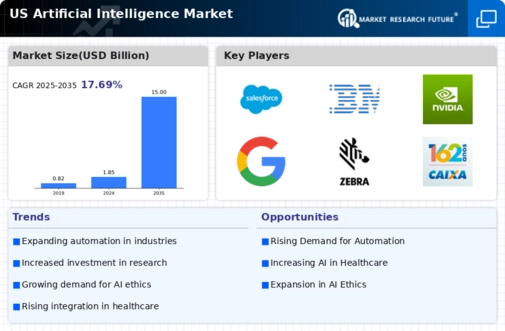The artificial intelligence market is currently characterized by intense competition and rapid innovation, driven by advancements in machine learning, natural language processing, and automation technologies. Major players such as Microsoft (US), Google (US), and NVIDIA (US) are at the forefront, each adopting distinct strategies to enhance their market positioning. Microsoft (US) focuses on integrating AI capabilities into its cloud services, thereby facilitating digital transformation for enterprises. Google (US), on the other hand, emphasizes research and development, particularly in generative AI, which has become a cornerstone of its product offerings. NVIDIA (US) leverages its graphics processing units (GPUs) to power AI applications, positioning itself as a critical enabler of AI infrastructure. Collectively, these strategies contribute to a competitive landscape that is both dynamic and multifaceted, with each company striving to carve out a unique niche.
In terms of business tactics, companies are increasingly localizing their operations and optimizing supply chains to enhance efficiency and responsiveness. The competitive structure of the market appears moderately fragmented, with a mix of established giants and emerging startups. This fragmentation allows for diverse innovation pathways, although the influence of key players remains substantial, as they set industry standards and drive technological advancements.
In October 2025, Microsoft (US) announced a strategic partnership with a leading healthcare provider to develop AI-driven solutions aimed at improving patient outcomes. This collaboration underscores Microsoft's commitment to leveraging AI in critical sectors, potentially transforming healthcare delivery through enhanced data analytics and predictive modeling. Such initiatives not only bolster Microsoft's market presence but also highlight the growing intersection of AI and healthcare.
In September 2025, Google (US) unveiled a new suite of AI tools designed for small and medium-sized enterprises (SMEs), aimed at democratizing access to advanced technologies. This move is significant as it reflects Google's strategy to broaden its customer base and foster innovation among SMEs, which are often underserved in the tech landscape. By providing accessible AI solutions, Google positions itself as a facilitator of growth and efficiency for smaller businesses, thereby enhancing its competitive edge.
In November 2025, NVIDIA (US) launched a new AI platform that integrates advanced machine learning capabilities with edge computing. This development is pivotal as it addresses the increasing demand for real-time data processing in various industries, including automotive and manufacturing. By enhancing its product offerings, NVIDIA not only solidifies its leadership in AI hardware but also responds to the evolving needs of its customers, ensuring sustained relevance in a fast-paced market.
As of November 2025, current trends in the artificial intelligence market are heavily influenced by digitalization, sustainability, and the integration of AI across various sectors. Strategic alliances are becoming increasingly vital, as companies recognize the need for collaboration to drive innovation and address complex challenges. Looking ahead, competitive differentiation is likely to evolve, shifting from traditional price-based competition to a focus on innovation, technological advancement, and supply chain reliability. This transition suggests that companies that prioritize these elements will be better positioned to thrive in an increasingly competitive environment.























Leave a Comment